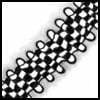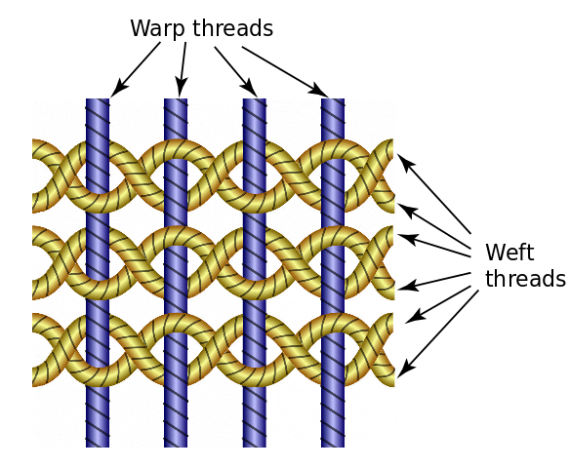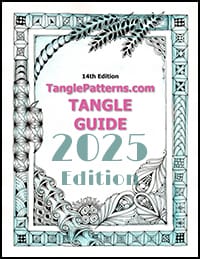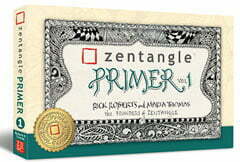 Welcome to another week of fun and creative tangles on this, the last day of Summer 2020. One for the books.
Welcome to another week of fun and creative tangles on this, the last day of Summer 2020. One for the books.
So much is happening in our social and political lives these days. It’s head-spinning and wearying, and worrying. Frankly, I’m feeling quite worn out by it all and I suspect I’m not alone in this “disaster fatigue” phenomenon. But …
Super easy tangle to the rescue!
Faid is a ribbon-style tangle from Belgian CZT Rita Nikolajeva and it’s her fifth on the site. Of course I enjoy them all, but I think Borbz has been my personal fave.
Faid not only works great as a ribbon but it’s also a cool background tangle when the ribbons are placed side-by-side as Rita demonstrates.
She notes,
I call it Faid (for First Aid), because it looks like first-aid gauze 🙂
Okay, who knew something as simple as gauze would have a fascinating story behind it !?
According to Wikipedia:
Gauze is a thin, translucent fabric with a loose open weave. In technical terms “gauze” is a weave structure in which the weft yarns are arranged in pairs and are crossed before and after each warp yarn keeping the weft firmly in place. This weave structure is used to add stability to fabric, which is important when using fine yarns loosely spaced.
 Gauze was traditionally woven in Palestine. The English word is said to derive from the place name for Gaza, a center of weaving in the region. Despite a prohibition on trade with non-Christians from religious authorities in medieval Europe, a fine type of silk known as gazzatum was imported from Gaza as early as the 13th century. Though members of religious orders in Europe were forbidden to wear it, the fabric won a place for itself and emerged into modern life as gauze.
Gauze was traditionally woven in Palestine. The English word is said to derive from the place name for Gaza, a center of weaving in the region. Despite a prohibition on trade with non-Christians from religious authorities in medieval Europe, a fine type of silk known as gazzatum was imported from Gaza as early as the 13th century. Though members of religious orders in Europe were forbidden to wear it, the fabric won a place for itself and emerged into modern life as gauze.
Gauze was originally made of silk and was used for clothing. It is now used for many different things, including gauze sponges for medical purposes. When used as a medical dressing, gauze is generally made of cotton. It is especially useful for dressing wounds where other fabrics might stick to the burn or laceration.
On flickr, look for this arrow in the lower right corner of your screen to download the steps.
My example of Faid is one of the variations Rita demonstrates with her steps illustration. Her sample tile shows ribbons of Faid overlapping each other using the technique we first saw in CZT® Mary Elizabeth Martin’s tangle Laced.
Rita illustrates the step-by-step instructions for drawing tangle here on flickr where she’s known as terem.
As you enjoy any of the tangles on the site, please leave a comment of thanks and encouragement to show the artists you appreciate them for sharing their creativity to inspire yours. Your thanks helps motivate them to continue to share! And please share a link to your favorite tangles on social media. Thanks!
Check out the tag ritan for more of Rita’s tangles on TanglePatterns.com.
.oOo.
Share your tangle on TanglePatterns
Everyone is invited to share patterns on TanglePatterns.com, you do NOT need to be a CZT. In order for patterns to be considered for publication they must be submitted to me by email. In other words you have to let me know about them.
For a submission to qualify as a tangle it must be a genuine pattern (“a regularly repeated arrangement, especially a design made from repeated lines, shapes, or colours on a surface”) and not the repetition of “a thing to draw”.
From The Book of Zentangle:
“Keep it Non-representational. Zentangle artwork is intended to be non-representational. Zentangle’s elemental strokes are also non-representational.
We don’t teach complex elements such as hearts, stars or flowers. Tangles are also non-representational.”
Remember that tangles never start with pencil planning.
"A tangle has no pre-planning with pencil guidelines, grids or dots, no erased lines."
If you need a refresher on what makes a tangle, read the A PATTERN IS NOT ALWAYS A TANGLE page on the ZENTANGLES menu bar at the top of any page.
For details on how to submit your pattern for consideration visit the SUBMIT YOUR PATTERN page on the top menu bar of any page on the site. On that menu you will find these two pages:
The first page includes instructions on how to prepare and send your JPGs. (Please save me time and do not send PDFs.) It also includes a link to this PDF submission form.
When your examples include additional tangles from the site, please list them in your email. (This saves me time and my memory some wear and tear.)
If your pattern is posted on your blog, attach your steps and tile JPGs to your email and be sure your email includes the direct URL so I can link to it.
And remember, to quote Zentangle's co-founders Rick and Maria: tangles should be "magical, simple and easy to create", non-objective patterns of repetitive strokes that are easy to teach and offer a high degree of success to tanglers of all ages.
"Keep the tangles as little like 'drawing something' as possible."
.oOo.
Related Links
- Looking for tangles by Artist or Type? For details visit the ABOUT > HOW TO FIND TANGLES BY ARTIST OR TYPE page on the top menu bar of any page on the site.
- What is a Zentangle? — if you are new to the Zentangle Method, start here for the fundamentals.
- Zentangle terminology — a glossary of terms used in this art form.
- How to use the site — an excellent free video tutorial showing how to use the site as well as pointing out lots of useful features you might have missed.
- Linda's List of Zentangle-Original Patterns — here is the complete list of original tangles (aka "official tangles") created and introduced by founders Rick Roberts and Maria Thomas, including those not published online. If you are new to the Zentangle Method I highly recommend learning a few of the published Zentangle classics first.
- "A Zentangle has no up or down and is not a picture of something, so you have no worries about whether you can draw a hand, or a duck. You always succeed in creating a Zentangle." Patterns that are drawings of a recognizable naturalistic or actual object, figure, or scene, are not tangles. A pattern is not always a tangle — here's what makes a tangle. TIP: tangles never start with pencil planning.
- Un motif n’est pas toujours un tangle — Qu’est-ce qu’un tangle ?
- Un diseño no es siempre un tangle — ¿Qué es un tangle?
- How to submit your pattern deconstruction to TanglePatterns
- For lots of great FREE tutorials on TanglePatterns, click on the TUTORIALS link in the pink alphabetic menu bar below the tangle images at the top of any page.
- Strings! Have we got STRINGS! Click on the STRINGS link in the pink alphabetic menu bar below the tangle images at the top of any page for 250 different (free) Zentangle-starters. More than enough for any lifetime!
- Never miss a tangle! FREE eMAIL NEWSLETTER - visit the Here's how to SUBSCRIBE button (top of left sidebar on any page) and sign up to get notices delivered free to your inbox.
- If you have questions about the TanglePatterns.com TANGLE GUIDE, visit the BOOK REVIEWS tab on the top menu bar of any page on the site for COMPLETE details!
|
.oOo. |
|
Enhance your Zentangle experience while supporting TanglePatterns: |
|
CURRENT EDITION! TanglePatterns.com TANGLE GUIDE, 2025 Edition |
|
 |
The 14th Edition of the TanglePatterns.com TANGLE GUIDE is an instant-download 117-page interactive digital eBook/PDF containing over 2,000 tangles on the site from May 2010 through December 31, 2024. It's a great resource and a must-have digital tool for using the site. Visit the STORE > E-BOOKS page and help keep TanglePatterns.com going by getting your copy now! |
|
"Linda, Thank you! I was relying on too few and getting stuck after 3 years of daily working with Zentangle. This has inspired me to ‘begin again’ with renewed excitement." ~ Barbara R. |
|
| See the BOOK REVIEWS page for more details on its features and view a sample page. Note: this is a digital product you download immediately when you place your order, nothing will be physically mailed to you. | |
| If you're new to Zentangle® and tangling, my TanglePatterns.com BEGINNER'S GUIDE TO ZENTANGLE is just what you need to get started. Also available en Français and en Español. | |
|
|
|
 |
This is the only Zentangle book you'll ever need: the fabulous Zentangle PRIMER Vol 1. It's your CZT-in-a-book by the founders of Zentangle®. Visit the STORE tab on the top menu bar or click on the image. For more about the content and to read the rave reviews, visit the BOOK REVIEWS tab. |
| Now available in KINDLE format for $9.99. Spanish Edition here. Japanese Edition here. | |
| "Absolutely the best Zentangle Book yet! As an accomplished artist I used to think I did not need instruction on this art form. How wrong I was! My tangling improved by leaps and bounds after reading this book. If you think you have Zentangle down then you need this book more than ever!" ~ Kris H | |
|
|
|
|
.oOo. |
|








Very playful and easy to tangle in many fun ways! Thanks for this tangle 🙂